A Novel Numerical Algorithm for Optimal Sizing of a Photovoltaic/Wind/Diesel Generator/Battery Microgrid Using Loss of Load Probability Index
Abstract
This paper presents a method for determining optimal sizes of PV array, wind turbine, diesel generator, and storage battery installed in a building integrated system. The objective of the proposed optimization is to design the system that can supply a building load demand at minimum cost and maximum availability. The mathematical models for the system components as well as meteorological variables such as solar energy, temperature, and wind speed are employed for this purpose. Moreover, the results showed that the optimum sizing ratios (the daily energy generated by the source to the daily energy demand) for the PV array, wind turbine, diesel generator, and battery for a system located in Sohar, Oman, are 0.737, 0.46, 0.22, and 0.17, respectively. A case study represented by a system consisting of 30 kWp PV array (36%), 18 kWp wind farm (55%), and 5 kVA diesel generator (9%) is presented. This system is supposed to power a 200 kWh/day load demand. It is found that the generated energy share of the PV array, wind farm, and diesel generator is 36%, 55%, and 9%, respectively, while the cost of energy is 0.17 USD/kWh.
1. Introduction
Hybrid photovoltaic (PV)/wind/diesel power generating system installation has played an important role due to the fact that the system is clean, environment friendly, and a secure energy source. Currently, some research works are carried out focusing on optimization of hybrid PV/wind/diesel power generating system so that the capacity of PV array, wind turbine, diesel generator, and storage battery capacity can be optimally selected [1–6]. The hybrid PV/wind/diesel power generating system size and performance strongly depend on metrological variables such as solar energy, ambient temperature, and wind speed, and therefore, to optimize the system, extensive studies related to metrological variables have to be done [1]. Optimization works related to hybrid PV/wind/diesel system can be found in the literature [1–6]. In [2, 3], hourly meteorological variables such as wind speed, solar energy, and ambient temperature for specific locations in Saudi Arabia are used to design a PV/wind/diesel generator system. Intuitive mathematical relations have been developed to design the hybrid system but without any optimization.
The application of advanced optimization techniques for designing hybrid PV/wind/diesel systems can be found in [4–6]. In [4, 5], the Strength Pareto evolutionary algorithm is used to optimize a PV/wind/diesel generator system by formulating a two objective optimization problem. The objectives are to minimize system cost and pollutant emissions. The mathematical models of the energy sources included in the hybrid PV/wind/diesel system and the hourly meteorological data are used in designing the system. In [6], an iterative method and evolutionary algorithm are applied to optimize a hybrid PV/wind/diesel generating system. Here, a possible design space for the assumed load demand is first configured, and then an iterative method as well as evolutionary algorithm is used to determine the optimum configuration among the design space configurations. The generated design space contains over 6 million possible configurations. It is found that the evolutionary algorithm is faster than the iterative method in finding the optimum design space configuration [6]. However, in this optimization method, the availability of the hybrid system configuration which has availability values in the range of 0–100% is not considered, and this results in a large size of the design space. If a specific availability level is considered, the size of the design space would have been significantly reduced. In addition, actual values of equipment have been used thus making the results limited to the assumed load demand. By using a defined sizing ratio, the method is not case specific and applicable for any load demand. Finally, in [7–9], the HOMER software has been used to optimally size hybrid PV/wind/diesel generating systems by considering the weather profile of Malaysia.
In this paper, a novel optimization method taking into consideration the maximum availability and the minimum system capital cost has been developed for optimal sizing of a building integrated PV/wind/diesel generating system. To evaluate the effectiveness and accuracy of the proposed optimization method, it is compared with the method employed in the HOMER software. The meteorological data for Sohar provided by Sohar University has been used in this work.
2. Modeling of Energy Sources in the Hybrid PV/Wind/Diesel Generating System
The proposed building integrated multigenerator system consisting of PV array, wind turbine, battery storage, and diesel generator as the main energy sources is shown in Figure 1. The system is designed to supply a building load while the excess energy will be injected to the grid. The building load is mainly supplied by the PV array and the wind turbine. When the energy produced by the PV array and the wind turbine, is not sufficient to fulfill the load demand, the battery will cover the energy deficit. However, in case that the energy produced by the PV array, wind turbine, and the battery is not able to meet the load demand, the diesel generator will cover the remaining load and charge the battery until reaching its maximum state of charge.
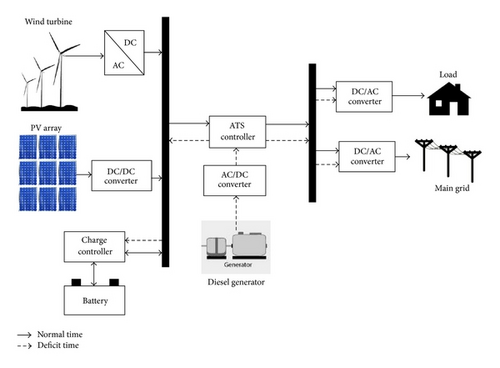
As for the wind generator, its output power is a function of wind speed as illustrated in Figure 2.
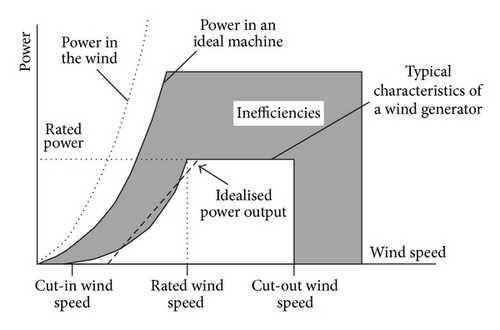
3. Proposed Optimization Algorithm
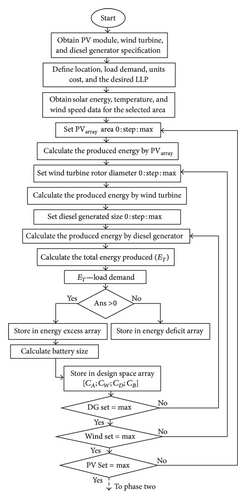
In the second phase of the optimization algorithm as illustrated in Figure 4, the generated design space is used to perform a simulation of the system in order to calculate the availability level of the system. In this phase, the total output power which is generated by the PV array and the wind turbine is calculated. Then the energy balance is examined by subtracting the load demand from the generated power. At this point, if the energy balance is negative (the generated power is not able to cover the load demand), the battery state of charge (SOC) is checked to find out whether the battery is able to supply energy or not. If the battery SOC is higher than its minimum value, then the battery is supposed to supply the remaining load demand subject to not reaching the allowable minimum SOC. On the other hand, if the battery is not able to supply the load (SOC = Min), the diesel generator is operated to cover the remaining load and to charge the battery. However, if both the battery and diesel generator are not able to cover the remaining load demand, this energy is classified as energy deficit. This procedure is done for each hourly load demand for a duration of one year, and at the end of the year, the total energy generated by PV, wind turbine, and diesel generator is calculated. In addition, the total energy deficit is calculated in order to calculate the loss of load probability. This loop is repeated till reaching the maximum length of the design space array. Finally, all the system configurations that investigate the desired availability level are stored in an array called as the possible configuration area (Figure 4).
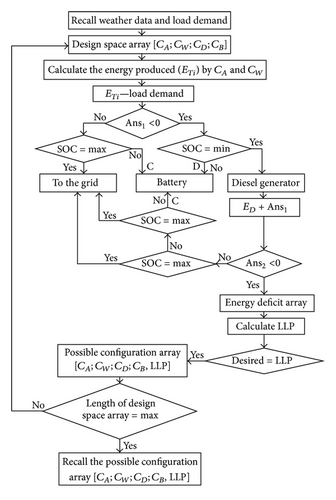
4. Test Results
Optimization of the building integrated hybrid PV/wind/diesel generating system for Sohar, Oman, has been conducted by considering the average hourly solar energy and wind speed which are in the range of 4.5–5.2 kWh/m2 and 1.3–5.1 m/s, respectively. For feasibility of installing the hybrid PV/wind/diesel generating system, the sites must have acceptable average daily wind speed. Figure 5 shows the monthly averages of solar energy and wind speed for Sohar. From the figure, the annual daily average of solar energy is 5.12 kWh/m2 with the highest value in April and the lowest value in December. Meanwhile, February and March have the highest wind speed, while June has the lowest wind speed. The average wind speed is 4.9 m/s.
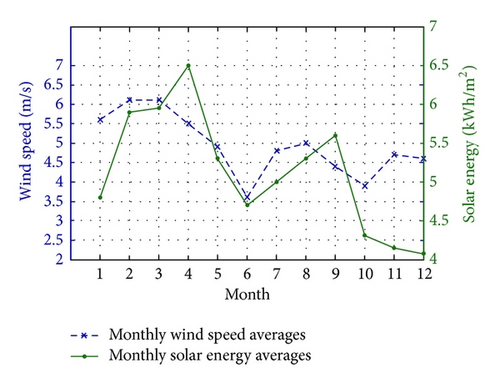
In this research, the proposed system is supposed to supply a 200 kWh/day (16 kW peak) to a building located in Sohar subject to 1% LLP. Figure 6 shows the design space for the proposed system in which all the configurations are able to supply the load with 1% of LLP. Among these configurations, the optimum configuration is the one which has the minimum cost. The optimization results showed that the optimum sizing ratios (CA, CW, CD, and CB) for the proposed system located in Sohar are 0.737, 0.46, 0.22, and 0.17, respectively. From these values, the system consisting of 30 kWp PV array, 18 kWp wind farm, 5 kVA diesel generator at 0.85 power factor, and 2.8 kAh/12 V battery is recommended to supply the load demand.
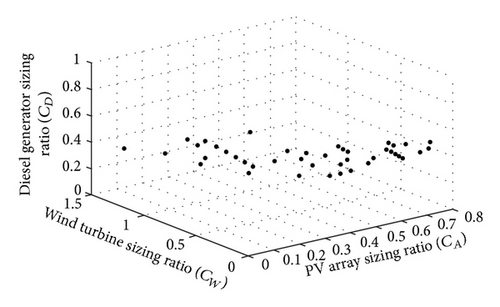
Figure 7 shows the energy generation shares in the proposed system. The PV array produces 29366 kWh per annum; meanwhile, the wind energy production is 44479 kWh per annum. In addition, the diesel generator produces 6822 kWh per annum. As for the battery, it is used in almost 25% of the year time. Figure 8 shows the energy that is to be sold to the grid and the energy deficit cases as well. From the figure, 7358 kWh per annum is supposed to be sold to the grid while the energy deficit for a period of one year is 753 kWh. The energy demand of the proposed system is 73000 kWh/annum, and consequently the loss of load probability of the proposed system is 1.03%.
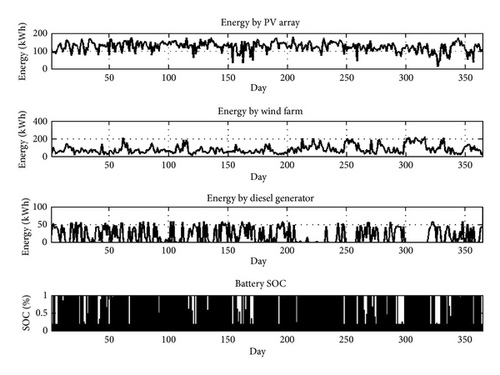
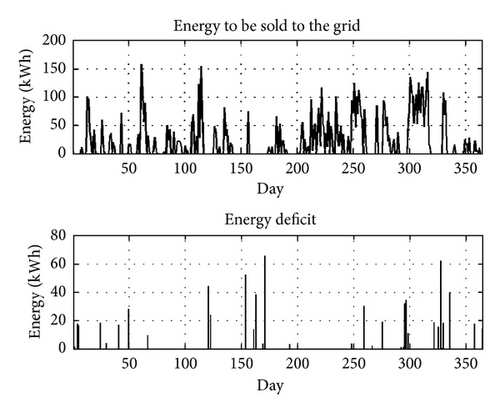
Table 1 shows the cost of the various components in the proposed system cost and the total cost of the system which is 207,228 USD. The system cost is calculated based on the cost of energy generated by the proposed system which is about 0.17 USD/kWh. In Oman, the cost of energy supplied by the electric utility is 0.11 USD/kWh, and this means that the approximate annual feed in tariff is 810 USD, calculated by multiplying the annual energy injected to the grid with 0.11/kWh. While annual saving is calculated by multiplying the sum of the annual energy that is supposed to be supplied by the Omani electricity grid with the price of kWh in Oman, the approximate annual saving is found to be 8850 USD.
| Item | Unit cost ($) | Capacity/quantity | Consumption | Cost ($) | Life time years/hours |
|---|---|---|---|---|---|
| PV modules | 3.71/Wp | 30 kWp | — | 111,300 | 20 |
| Support structure | 50/unit | 56 | — | 2,800 | 20 |
| Wind turbine | 1200/kWp | 18 kWp | 21,600 | ||
| Generator | 3600/DG | 2 | — | 7,200 | 13 years |
| Diesel | 0.6/L | 26000 L | 2.7 L/h | 15,600 | — |
| Engine oil | 1.4/L | 135 | 3.5 L/150 h | 189 | — |
| Diesel filter | 4.5 | 12 | — | 54 | 750 h |
| Air filter | 35 | 3 | — | 105 | 3000 h |
| Overhaul | 1500 | 1 | — | 1500 | 26,280 h |
| Storage battery | 2.3/Ah | 2.8 kAh | — | 12880 | 10 |
| Charge regulator | 8000 | 1 | — | 8000 | 20 |
| Inverters | 8000 | 3 | — | 24,000 | 20 |
| Circuit breakers | 200 | 4 | — | 800 | 20 |
| Installation materials | — | — | 600 | — | |
| Civil and installation work | — | — | — | 600 | — |
| Total cost | 207,228 | 20 | |||
| Scrap value | 15% |
4.1. Comparison with the HOMER Software
The proposed optimization algorithm for determining optimal sizing and cost of the hybrid PV/wind/diesel generating system has been validated by comparing it with the optimization method available in the HOMER software. Figure 9 shows the designed system specification using the HOMER software in which the system consists of 36 kWp PV array, 15 kWp wind turbine (3 kWp times 5 units), 5 kW diesel generator, and 3 kAh/12 V storage battery (500 Ah times 6 units).

From Figure 9, there is a slight difference between the energy sources capacity calculated using HOMER and the proposed optimization method. The PV array capacity of the proposed optimization method (30 kWp) is 83% of the PV array capacity calculated using HOMER (36 kWp). Meanwhile, the wind turbine capacity calculated using HOMER (15 kWp) is 83% of the wind turbine capacity of the proposed optimization method (18 kWp). On the other hand, the battery capacity of the proposed optimization method (2.8 kAh) is less by 7% than that calculated using HOMER (3 kAh). As for the diesel generator, similar size is determined by both optimization methods. The differences in the PV, wind, and battery sizes may be due to the assumed values of the PV module and wind turbine energy conversion efficiencies, battery charging and discharging efficiencies, power conversion devices efficiencies, PV module and wind turbine unit cost, battery unit cost, diesel cost, scrap costs, and other factors such as assumed life time of the system components. However, the most important reason for the difference in energy source sizes is due the nature of the used meteorological data. The HOMER software uses the monthly average of solar energy and wind speed, and this converts it to hourly values using statistical models which may have a specific error. Meanwhile the proposed optimization method uses the daily solar energy and wind speed. From [11–16], the use of monthly meteorological data may cause over sizing or under sizing of the designed system. The advantage of the proposed optimization method is that it provides a daily simulation of the designed system performance to define the availability of the system accurately while the HOMER software does not have this capability. In addition, the proposed optimization method provides useful information about energy generation, excess energy, and exact energy deficit times of the designed system.
5. Conclusion
Optimization of a building-integrated PV/wind/diesel generator and battery system has been implemented using the proposed optimization method based on iterative simulation. The objective of the optimization problem is determine the optimal sizes of the PV/wind/diesel generators and battery to supply a building load demand at minimum cost and maximum availability. The mathematical models of the various system components have been developed, and the meteorological variables such as solar energy, temperature, and wind speed are used. The results showed that the optimum sizing ratio for the PV array, wind farm, diesel generator, and battery for a system located in Sohar, Oman, is 0.737, 0.46, 0.22, and 0.17, respectively. The cost of the energy produced by the proposed system is 0.17 USD/kWh while the feed in tariff of the system is 810 USD/year. The proposed optimization method is found to give more accurate results compared to the method used in the HOMER software. The proposed optimization method can be applied for determining optimal sizes of renewable energy systems for housing electrification in Oman.
Conflict of Interests
The authors confirm that there is no conflict of interests with the developer or distributor of HOMER software. They have used the software as a part of the conducted research.
Acknowledgments
The research leading to these results has received Research Project Grant Funding from the Research Council of the Sultanate of Oman, Research Grant Agreement no. ORG SU EI 11 010. The authors would like to acknowledge the support from the Research Council of Oman. Gratitude is also expressed to the Faculty of Engineering and Research and Industry Collaboration Office in Sohar University.




